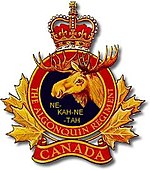The Algonquin Regiment
| The Algonquin Regiment (Northern Pioneers) | |
|---|---|

Badge of the Algonquin Regiment
|
|
| Active | 1 July 1900–present |
| Country | Canada |
| Branch | Canadian Army, Militia |
| Type | Line infantry |
| Role | Light role |
| Size | Two companies |
| Part of | 33 Canadian Brigade Group |
| Garrison/HQ | Fort Chippewa Barracks, North Bay, Ontario |
| Nickname(s) | None |
| Motto(s) | Ne-kah-ne-tah (We lead others follow) |
| March | "We Lead, Others Follow" |
| Commanders | |
| Current commander |
Lieutenant-Colonel K McLure |
The Algonquin Regiment (Northern Pioneers) is a Primary Reserve infantry regiment of the Canadian Army comprising two companies. A Company is located in North Bay, Ontario, and B Company is located in Timmins, Ontario. The regiment falls under the command of the 4th Canadian Division's 33 Canadian Brigade Group.
Details of the 23rd Regiment "The Northern Pioneers" were called out on active service on 6 August 1914 for local protection duties.
The 122nd Battalion (Muskoka),CEF was authorized on 22 December 1915 and embarked for Great Britain on 2 June 1917. There, its personnel were absorbed by the Canadian Forestry Depot, CEF on 10 June 1917 to provide reinforcements. The battalion disbanded on 1 September 1917.
The 159th Battalion (1st Algonquins), CEF was authorized on 22 December 1915 and embarked for Great Britain on 31 October 1916. There, its personnel were absorbed by the 8th Reserve Battalion, CEF on 20 January 1917 to provide reinforcements for the Canadian Corps in the field. The battalion disbanded on 27 July 1917.
The 162nd Battalion (Parry Sound), CEF was authorized on 22 December 1915 and embarked for Great Britain on 31 October 1916. There, its personnel were absorbed by the 3rd Reserve Battalion, CEF and the 4th Reserve Battalion, CEF on 4 January 1917 to provide reinforcements for the Canadian Corps in the field. The battalion disbanded on 15 September 1920.
The 228th Battalion (Northern Fusiliers), CEF was authorized on 15 July 1916 and embarked for Great Britain on 16 February 1917. There, it was redesignated as the 6th Battalion, Canadian Railway Troops, CEF on 8 March 1917. The battalion landed in France on 3 April 1917, where it provided railway construction support on the British sector of the Western Front until the end of the war. The battalion disbanded on 23 October 1920.
...
Wikipedia
